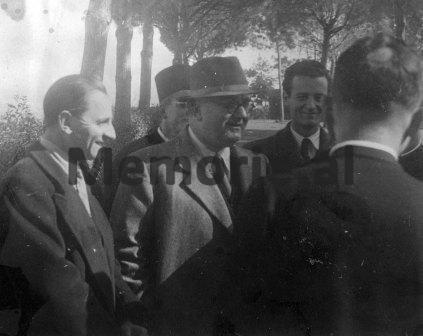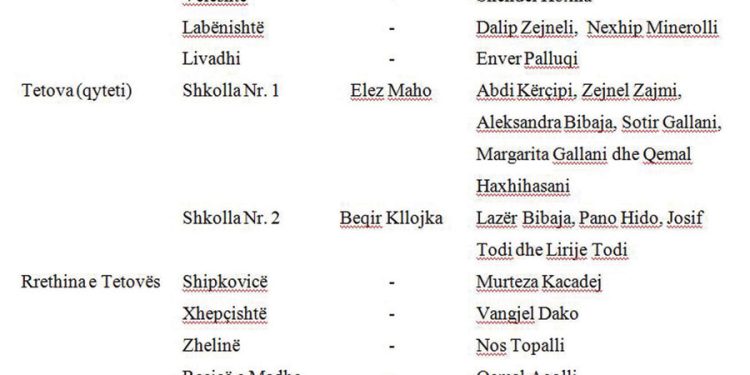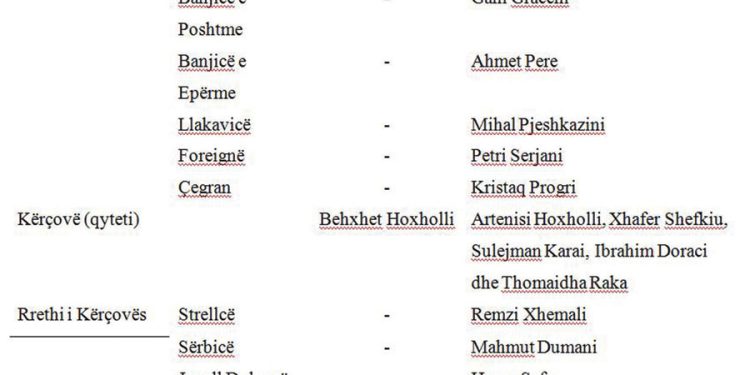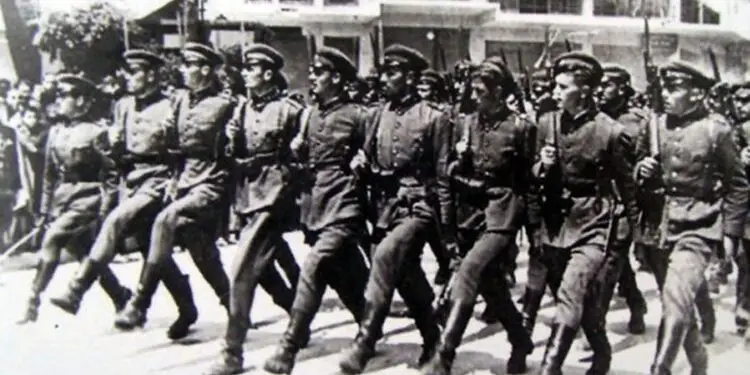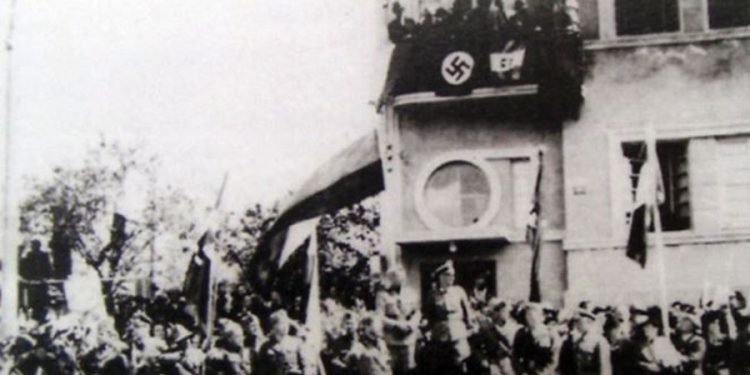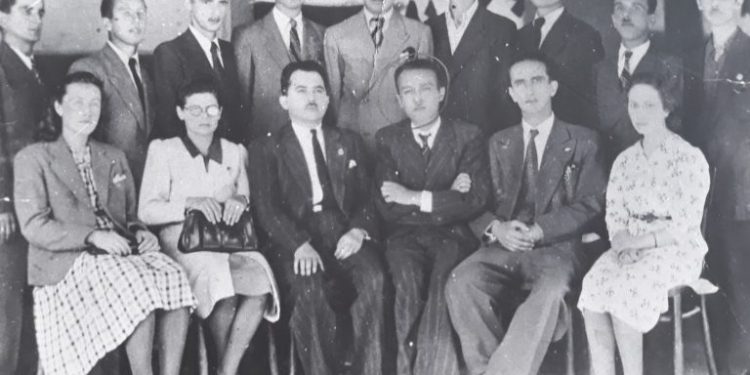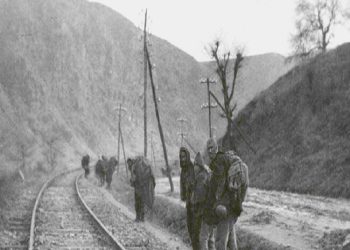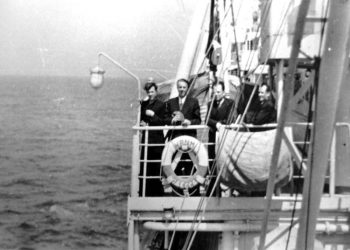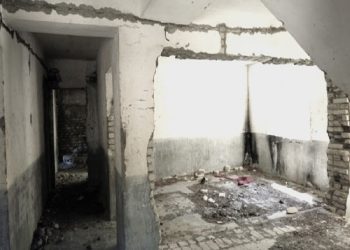By Qerim LITA and Halim PURELLKU
Memorie.al / On April 6, 1941, German troops attacked Yugoslavia and, on April 17, 1941, in Belgrade, Yugoslavia signed an unconditional capitulation. In this context, on April 6, 1941, the XII German Army which was stationed in Bulgaria, in addition to the air attack on Yugoslavia, marched on the territory of Baltovina of Vardar, from three directions. After the occupation of Skopje, on April 7, 1941, the German troops of the IX Division occupied Tetova without a fight on April 8, on April 9, they occupied Gostivar and on April 10, they took Mavrova Inns, continuing the march to Gryka e Radika , towards Dibra. The next day, on April 11, the German armored units, after approaching the city of Dibra, attacked from behind the Yugoslav troops of the 46th regiment, of the Vardar Division, who were fighting with the Italian troops on the “Dibra Front”.
After brief fighting, that day German troops routed the Yugoslav forces and occupied the Dibra. The next day, on April 12, Italian troops also entered Dibër. After the defeat of the Yugoslav troops on the “Dibra Front”, a part of the effectives, many officers and the commander of the Vardar Division, were captured by the German troops. Another part of the effectives of this Division were dispersed and some of them penetrated to Kicevo. Meanwhile, on April 10, 1941, German troops entered Ohrid and Struga, establishing contact with Italian troops there.
In a state of chaos, when the Yugoslav troops had already been defeated and gathered around Kirčova, the Yugoslav general, Naumović, made a decision for their capitulation, and on April 12-13, 1941, the German troops also occupied Kirçova.
Meanwhile, after the establishment of military borders in Yugoslavia, according to German interests, Hitler asked Bulgaria to occupy the part of Yugoslavia, up to the military border line, which extended to: Pirot-Vraj-Skopje and, in continuation, along the Vardar valley, up to the Greek border.
The invasion of the Bulgarian army into the territory of Yugoslavia began on April 18, 1941. Also, in accordance with the agreement of April 26, 1941, on the division of spheres between Germany and Italy, the Italian invading troops of the “Firenze” Division, with the Headquarters in Dibër, during the night of May 9-10, 1941, they entered Struga, Gostivar, Kicevo and Tetovo and their surroundings, thus replacing the German occupation troops.
Immediately after the German-Italian invasion, the “Albanian Committee” was formed in Dibër, whose members were; Sherif Langu, Osman Piperku, Daut Imami, Nuri Shehu, Osman Rusi, Ali Maliqi, Hysni Dine, Sabri Maqellara, Uke Saliu, Uke Cami, etc.
This Committee set several objectives before itself: the union of the Albanian provinces with the Albanian state; the creation of Albanian government bodies; civil and judicial, in the “liberated” years; the opening of Albanian schools in Dibër and its surroundings; the strengthening of Albanian consciousness among the Albanians of this area, etc. Such Albanian committees would be formed for the same purposes in other cities, as in; Gostivar, Tetovo, Kicevo, etc. For the realization of common objectives, these committees were oriented towards mutual cooperation and interaction.
According to the agreement between the Minister of Foreign Affairs of Italy, Ciano, and the Minister of Foreign Affairs of Germany, von Ribbentrop, (reached in Vienna on April 21-22, 1941), on the division of spheres of interest in the Balkans, five cities with surroundings, or six districts/sub-prefectures, namely: the cities of Tetovo, Gostivar, Kîçovo, Dibër, Struga with surroundings and the area of Reka e Dibra, as well as some villages of Prespa, were included in the Italian occupation zone.
The temporary line of demarcation, between Italy and Bulgaria, in the Albanian Eastern Territories, was as follows: to the west of Kaçanik – towards the villages of Leshok and Zhillçe – to the east of the villages of Zhelezna Reka (Gostivar) and Novoselë and Kërcovo – towards the village of Mafmute (Kërçovo ), then from the villages of Dolenca e Epërme and e Poshtme (Kërçovo) – to the villages of Staroec (disappeared village – Kërçovo) – Belicë-Vellmej and Mesheishtë (Ohër), coming out in the village of Podmolje, between Ohrid and Struga, then continuing through the Lake of Ohrid and exited five kilometers south of the city of Ohrid, continuing along Mount Galicica, exited to the village of Evla i Prespa, from there it continued to the east of the village of Kozjak and the peaks of Mount Baba on the Yugoslav-Greek border. But this border line would undergo some modifications over time, mainly in favor of Bulgaria.
THE ORGANIZATION OF THE ITALIAN MILITARY POWER
The German occupation troops in the cities of Dibër, Struga, Kîçovo, Gostivar, Tetovo and their surroundings were replaced in the night between May 9-10, 1941, by the Italian occupation troops of the “Florence” division, with the Headquarters in Dibër. On May 17, 1941, Mussolini’s Decree followed, on the basis of which the country’s military commands began to organize and establish Italian power in the areas: Dibër, Struga, Kîçovo, Gostivar and Tetovo. Italian power in these areas was established in two phases:
In the first phase, on the part of the country’s military commands of the “Florence” division, in addition to the military power, the police power was also organized, through the establishment of the gendarmerie-carabinieri in the five cities mentioned and in their surroundings. In the second phase, the state administration was organized. Specifically, the Italian military commands of the country organized and established civil and judicial power in districts and municipalities. At the head of the civil power were the civil commissars, appointed by the Supreme Command.
The civil commissars took care of maintaining order and peace, as well as the activities of the Italian government. The process of organizing the Italian military-police power in the mentioned areas (Dibër, Struga, Kîçovo, Gostivar and Tetovo) lasted several months; from April to July of 1941, so this was also a “period without power”, because the former Yugoslav administration that left was not being replaced by a new administration.
ORGANIZATION OF THE ALBANIAN CIVIL POWER
In July 1941, with the Proclamation of the Duke on June 29, 1941, the territories of Dibra, Struga, Reka e Dibra, Kîrçova, Gostivar and Tetova were annexed (joined) to Albania. After the annexation, in these territories the administrative bodies and judicial power ceased to function until then and the Albanian government was organized with a management structure, the High Civil Commissariat for Kosovo, Dibër and Struga, with headquarters in Prizren. Fejzi Alizoti was appointed the first head of the police station, with powers equal to that of a minister.
In August 1941, the territories of Dibra, Struga, Reka i Dibra, Kirčova, Gostivar and Tetova, in the civil administrative-territorial aspect, were organized within the prefecture (district) of Dibra, with headquarters in the city of Dibra.
So, the prefecture (district) of Dibra consisted of the sub-prefectures (districts) of Dibra, Struga, Reka (Radastush), Kicevo, Gostivar and Tetovo. The prefecture of Dibra had an area of 4070 km, with about 260,000 inhabitants.
Meanwhile, each district was divided into several territorial administrative units, which in urban areas were known as municipalities, while in rural areas, communes. At the head of the local administration of the prefecture was the prefect, while of the sub-prefecture stood the sub-prefect and of the municipality and commune stood, respectively, the mayor and the mayor of the municipality. The prefect and sub-prefects were proposed by the Ministry of Internal Affairs, while they were decreed by the viceroy Francesco Jacomoni. In addition, the prefecture of Korça was joined by five Albanian settlements in the district of Prespa that made up the municipality of Carev Dvor.
The administrative bodies of the Prefecture of Dibra began to work between the end of August and the beginning of September of 1941 but, in general, they were still not fully consolidated. So e.g. the Yugoslav courts were finally suspended by the order of October 28, 1941, while the official Albanian courts began their work from May 4, 1942. The law enforcement agencies were the gendarmerie (carabinieri) and the police (quests). The gendarmerie was commanded by Italians, while the police were commanded by Albanians. Meanwhile, the official language in the administration was the Albanian language.
About 1,500 gendarmerie forces were deployed in the territory of the prefecture of Dibra. The headquarters of the police formation (quaestures) of this prefecture was in Dibër, while the branches were in the headquarters of the sub-prefectures. Gendarmerie forces were systematized throughout the territory of this prefecture, in the municipalities of the cities from 20-30 gendarmes, while in the villages there were 4-5 gendarmes.
The gendarmerie forces consisted only of Italians, and only on the eve of Italy’s capitulation, Albanians began to be accepted. During the German and Italian military occupation, the Albanians of these territories did not support the National Liberation Movement of Yugoslavia, due to the fact that they enjoyed a high level of national rights under the Italian occupation.
During the years 1941-1944, the Albanians of these territories, for the first time in their modern history, were governed by an Albanian administration, although at the level of the lower administration. At that time, a broad base was created and prospects for an unstoppable cultural and national evolution were opened for them, a process which was not able to be completely stopped later even by the Yugoslav communist power.
ALBANIAN NATIONAL SCHOOLS IN DIBRA PREFECTURE
In the fall of 1941, the first Albanian national schools were opened in these areas. In fact, the preparations had been made much earlier, since mid-June, when the Minister of Education, Ernest Koliqi, appointed the “Extraordinary Educational Mission”, at the head of which was appointed the professor of the Lyceum of Shkodra, Fadil Repishti. The mission in question, as a primary task, had to study the actual state of primary and secondary education in those territories.
In addition, the Mission had to, in the shortest possible time, organize summer courses for learning the Albanian language for both minors and the elderly. For this purpose, on June 19, the Ministry of Education issued a circular, in which it was requested that, on a voluntary basis, a list of teachers who “show their desire to be transferred to the liberated countries” be drawn up.
Based on the inspectors’ reports, it is clear that a large number of teachers willingly agreed to work as teachers in the liberated lands. Within a short time, their number reached over 150. The first summer courses in the Albanian language in the territory of this prefecture had a great echo among the Albanian population who insisted that the teachers continue their sacred national mission, opening schools’ regular elementary school in the Albanian language.
Many letters and telegrams of thanks were sent to the Ministry of Education. It is important to point out that, in the report sent to the Ministry of Education on August 11, 1941, the “Extraordinary Educational Mission” for the liberated Dibra, among other things, requested that for the school year 1941/42, at least 55 Albanian primary schools in which 100 teachers would work.
The Council of Administration at the Ministry of Education, on October 1, 1941, took the decision to “open national primary schools in the provinces of Kosovo and Dibra”. On October 14, 1941, the Ministry of Education appointed Beqir Haçin as Inspector of primary education in Dibër, which would later include the district of Tetova as well as the districts of Gostivar, Kîçova and Struga.
At the same time, two didactic directors were appointed: Edip Tërshana for Dibër and Struga, while Mejit Bekteshi for Tetovo, Gostivar and Kîçovo. According to archival sources, it appears that the first schools in the Albanian language were opened at the beginning of November. In the circular telegram addressed to the primary education inspectorates, Ernest Koliqi stated in a clear and decisive manner that “the staff of Primary Education transferred to Kosovo and Dibër are not given any reason for not appearing in their new duties. The prayers they have submitted remain without action.
By 10 Under, their departure must have ended. On this day, announce those who do not want to leave, which will be considered as a violation of the order given”. The first teachers, who arrived in Dibra e Madhe, at the end of October, were mainly from the district of Peshkopia. They were immediately appointed teachers in the various settlements.
Teachers from other districts also arrived by the scheduled date. In addition to primary schools, the “Hoxhë Tahsini” Lyceum was opened in Tetovo, the Vocational High School in Gostivar, the “Muhamet Çami” work school in Kîçovo, and the industrial high school in Struga. The opening of the first Albanian national schools, in the newest Albanian historiography, is considered as the second Renaissance for the Albanians of these lands.
For this, great credit went to the Albanian teachers who, at the request of the Minister of Education, Koliqi, gladly contributed to the process of opening schools in the freed years, leaving all the privileges they enjoyed in their residences, only only that they came to the aid of their brothers, who had just been freed from thirty years of Serbian captivity.
During their three-year work, in addition to their educational contribution, they also helped the national awareness of the Albanian population of these regions, creating a constellation of the new generation who, after the end of the Second World War, resisted the communist violence and terror Yugoslav and managed to keep the “Albanian National Movement” alive. /Memorie.al
The next issue follows




